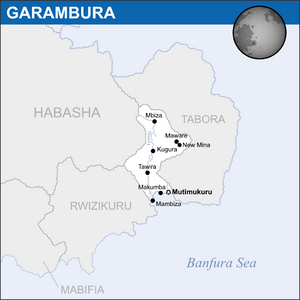Adesine: Difference between revisions
No edit summary |
No edit summary |
||
| Line 143: | Line 143: | ||
}} | }} | ||
The '''Republic of the Adesine''' (Gaullican: ''République du Adésine''), also known as '''RD Adesine''', '''ROA''', or simply the '''Adesine''', is located in Central [[Bahia]], on the continent of [[Coius]]. It is bordered by [[Mabifia]] to the southwest, [[Rwizikuru]] to the south, and [[Garambura]] to the southeast. The capital city of the Adésine is [[Granville]], which is also the largest city and financial centre of the country. | The '''Republic of the Adesine''' (Gaullican: ''République du Adésine''), also known as '''RD Adesine''', '''ROA''', or simply the '''Adesine''', is located in Central [[Bahia]], on the continent of [[Coius]]. It is bordered by [[Mabifia]] to the southwest, [[Rwizikuru]] to the south, and [[Garambura]] to the southeast. The capital city of the Adésine is [[Granville]], which is also the largest city and financial centre of the country. | ||
The river [[Adesine]] forms the western border of the nation, and is the geographical entity the nation is named after. The [[Gonda]] river flows from west to east, along the Barindi Valley. Evelin Falls, one of the biggest waterfalls in the world, is located in the south of the county and is part of the Gonda river. The Rwizikuru river originates in the extreme south of the country. | |||
Since the 11th century, present-day Adesine has been the site of several kingdoms and empires, and has been a major route for migration and trade. The [[Adesine Protectorate]], which was part of the greater [[Adesine colonial possessions of Gaullica]], was transfered to [[Werania]] after the end of the [[Great War (Kylaris)]]. Following independence in 1949, Adesine joined the [[United Bahian States]] in 1954. Several disagreements in foreign and domestic issues caused the United Bahian States to collapse, the Adesine withdrawing in 1964. | |||
The population is young, and predominantly located on the banks of the Adesine and Gonda rivers. Native to the Adesine area are the [[Asili people]], who originated from coastal areas but have migrated inland over thousands of years. The second largest ethnic group are the [[Rubandans]], who emigrated east across the Adesine river in the 16th-17th centuries, displacing the Asili that formerly lived there. Other ethnic groups include the [[Njarendie]] in the south-west, and the [[Sisulu]] in the south-east. | |||
Revision as of 08:21, 15 May 2020
Republic of the Adésine | |
|---|---|
Motto: "L'unité par la diversité" ("Unity through diversity") | |
 Garambura (dark blue) located within Coius (light blue). | |
 | |
| Capital | Granville |
| Largest city | Granville |
| Official languages | 4 languages: |
| Ethnic groups (2017) |
|
| Religion (2019) |
|
| Demonym(s) | Adésine |
| Government | Unitary parliamentary republic |
| Vincent Aphiwe Nombulelo | |
| Noël Kléber Abbas | |
| Legislature | Parliament |
| Senate | |
| National Assembly | |
| Independence from United Bahian Republic | |
• Declared | 1 July 1964 |
• Adésine Civil War | 30 April 1966 |
• End of Adésine Civil War | 4 January 1980 |
• Admitted to the CBS | TBD |
| Area | |
• Total | 364,300 km2 (140,700 sq mi) |
• Water (%) | 2.4% |
| Population | |
• 2020 estimate | 24,156,819 |
• 2019 census | 23,744,650 |
| GDP (PPP) | 2020 estimate |
• Total | $37.44 billion |
• Per capita | $1,530 |
| GDP (nominal) | 2020 estimate |
• Total | $15.24 billion |
• Per capita | $644 |
| Gini (2019) | high |
| HDI (2020) | low |
| Currency | Adésine Gaul (AGL) |
| Time zone | +3 |
| Date format | dd-mm-yyyy |
| Driving side | left |
| Calling code | +87 |
| Internet TLD | .ase |
The Republic of the Adesine (Gaullican: République du Adésine), also known as RD Adesine, ROA, or simply the Adesine, is located in Central Bahia, on the continent of Coius. It is bordered by Mabifia to the southwest, Rwizikuru to the south, and Garambura to the southeast. The capital city of the Adésine is Granville, which is also the largest city and financial centre of the country.
The river Adesine forms the western border of the nation, and is the geographical entity the nation is named after. The Gonda river flows from west to east, along the Barindi Valley. Evelin Falls, one of the biggest waterfalls in the world, is located in the south of the county and is part of the Gonda river. The Rwizikuru river originates in the extreme south of the country.
Since the 11th century, present-day Adesine has been the site of several kingdoms and empires, and has been a major route for migration and trade. The Adesine Protectorate, which was part of the greater Adesine colonial possessions of Gaullica, was transfered to Werania after the end of the Great War (Kylaris). Following independence in 1949, Adesine joined the United Bahian States in 1954. Several disagreements in foreign and domestic issues caused the United Bahian States to collapse, the Adesine withdrawing in 1964.
The population is young, and predominantly located on the banks of the Adesine and Gonda rivers. Native to the Adesine area are the Asili people, who originated from coastal areas but have migrated inland over thousands of years. The second largest ethnic group are the Rubandans, who emigrated east across the Adesine river in the 16th-17th centuries, displacing the Asili that formerly lived there. Other ethnic groups include the Njarendie in the south-west, and the Sisulu in the south-east.

